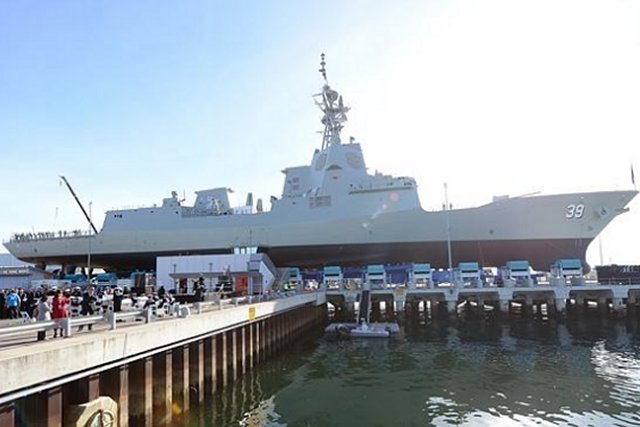Breaking news
Launch of the first Australian Navy Hobart Class Air Warfare Destroyer 24051501.
 The first Australian Navy Hobart Class Air Warfare Destroyer has been launched on May 23 (Picture: Tom Huntley) |
|||
Once
fully operational, the warships will have a combination of great endurance,
offensive and defensive weapons, flexibility and versatility. Hobart,
Brisbane and Sydney will assume a leading command and control role with
the Australian Defence Force and Coalition forces capable of carrying
out multi-mission operations.
The Air Warfare Destroyer (AWD) program is one of the largest and most complex Defence projects ever undertaken in Australia and has been instrumental in building a strong shipbuilding capability in Australia. The Hobart has reached this milestone through Government and industry collaboration involving an Australian workforce of some 3000 people. This includes the AWD Alliance made up of lead shipbuilder ASC, mission systems integrator Raytheon Australia and the Department of Defence, including the Royal Australian Navy. The program has also been supported the United States Navy, Navantia, Lockheed Martin, Forgacs, BAE Systems and MG Engineering. As Hobart moves into this next phase, the second and third destroyers, Brisbane and Sydney, will benefit from the AWD Alliance applying lessons learned. This experience will be drawn on should a continuous build strategy, with a regular pace of delivering new warships, be feasible. An enterprise-level naval shipbuilding plan would provide for the long-term future of the Australian naval shipbuilding industry and avoid the peaks and troughs we are experiencing – and have experienced in the past. With Hobart in the water, the second destroyer, Brisbane, can soon take its place on the hardstand to undergo final block consolidation, and the keel for the third destroyer, Sydney, will be laid. The AWDs are being built for Australia’s specific defence needs and will provide a significant increase in Australia’s defence capabilities. The AWDs will provide greater protection for ADF personnel by providing air defence for accompanying ships as well as land forces and infrastructure on nearby coastal areas. The AWDs will also provide self-protection against attacking missiles and aircraft. The Aegis Weapon System incorporating the state-of-the-art phased array radar, AN/ SPY 1D(V), in combination with the SM-2 missile, will provide an advanced air defence system capable of engaging enemy aircraft and missiles at ranges in excess of 150 kilometres. The AWDs will also carry a MH-60R Seahawk ‘Romeo’ naval combat helicopter for surveillance and response to support key warfare areas. The surface warfare function will include long range anti-ship missiles and a naval gun capable of firing extended range munitions in support of land forces. The AWDs will also be able to conduct Undersea Warfare and will be equipped with modern sonar systems, decoys and surface-launched torpedoes. Coupled with an array of close-in defensive weapons, all of these capabilities ensure the AWDs have the layered defensive and offensive resources required to win the battle against 21st century conventional and asymmetric threats. The Defence team is led by the AWD Program Office in the Defence Materiel Organisation (DMO), which retains overall responsibility for the project management and delivery of the three Air Warfare Destroyers. The DMO, through the Minister for Defence, is responsible to the people of Australia to ensure that the future AWDs are delivered to the RAN on time, on budget and to the required capability. |
|||



























